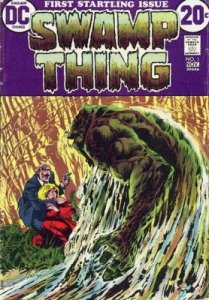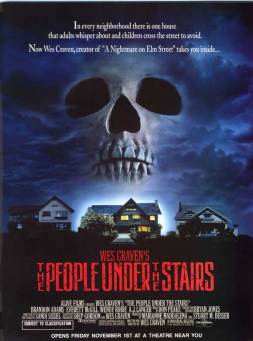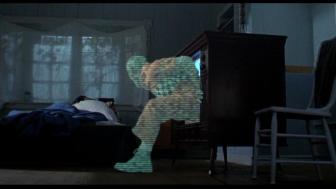Swamp Thing
Today, I’m going to be taking a look at Wes Craven’s comic book film adaptation: Swamp Thing.
The plot of Swamp Thing is summarized on IMDb as follows:
After a violent incident with a special chemical, a research scientist is turned into a swamp plant monster.
Swamp Thing was written and directed by acclaimed horror master Wes Craven. Craven is without a doubt one of the most influential horror filmmakers of all time, having been behind such films and franchises as Last House On The Left, Scream, A Nightmare on Elm Street, and The Hills Have Eyes. That said, Swamp Thing marked his first and only foray into the science fiction genre.
Swamp Thing is based on the comic series and character of the same name created by Len Wein and Bernie Wrightson. The character first appeared in House of Secrets #92 in July of 1971, which was intended as a standalone story. However, the character’s popularity led to an initial 24 issue solo series that ran throughout the mid-1970s. Since then, Swamp Thing has been a mainstay of DC comics.
 The cast for Swamp Thing was primarily made up of Louis Jourdan (Octopussy, The Return of the Swamp Thing), Adrienne Barbeau (The Fog, Creepshow, Batman: The Animated Series), Ray Wise (Dallas, RoboCop, Twin Peaks), and David Hess (The Last House on the Left, Zombie Nation).
The cast for Swamp Thing was primarily made up of Louis Jourdan (Octopussy, The Return of the Swamp Thing), Adrienne Barbeau (The Fog, Creepshow, Batman: The Animated Series), Ray Wise (Dallas, RoboCop, Twin Peaks), and David Hess (The Last House on the Left, Zombie Nation).
The cinematographer for the film was Robbie Greenberg, who also shot the films Free Willy, Under Siege 2: Dark Territory, and Wild Hogs. The editor for Swamp Thing was Richard Bracken, whose credits include The Hills Have Eyes Part II, numerous episodes of the television shows Ironside and Columbo, and work on six different Power Rangers series.
The musical score for Swamp Thing was provided by Harry Manfredini, who is best known for his work on the Friday the 13th franchise. However, he has plenty of other films to his credit, including A Talking Cat!?!, The Omega Code, DeepStar Six, and House.
 Two of the producers for Swamp Thing were Michael Uslan (The Dark Knight, Batman, The Spirit, The Lego Movie) and Benjiman Melniker (Mitchell, Constantine, National Treasure, Batman v Superman: Dawn of Justice).
Two of the producers for Swamp Thing were Michael Uslan (The Dark Knight, Batman, The Spirit, The Lego Movie) and Benjiman Melniker (Mitchell, Constantine, National Treasure, Batman v Superman: Dawn of Justice).
The makeup effects team for the film included Tonga Knight (Cosmos), Steve LaPorte (Van Helsing, Deep Blue Sea, Caddyshack II, The Howling), Ken Horn (Battle Beyond The Stars, The Hills Have Eyes), David Miller (Batman & Robin, The Mangler), and William Munns (Return of the Living Dead, The Beastmaster).
Swamp Thing was filmed primarily on Johns Island, which is located near Charleston, South Carolina. The island measures 84 square miles, and its marsh-y environment made it a perfect backdrop for the story.
Interestingly, Swamp Thing received a sequel many years later in 1989: The Return of Swamp Thing, which featured a handful of returning cast and crew members. However, it wasn’t received terribly well, and currently holds an IMDb user rating of 4.5/10.
The production budget for Swamp Thing was estimated to be $3 million. While I wasn’t able to dig up any box office numbers for the film, I suspect it made a profit due to its low price tag, and the fact that it received a sequel.
Swamp Thing wasn’t exactly embraced by audiences and critics. Currently, it holds an IMDb user rating of 5.4/10, along with Rotten Tomatoes scores of 64% from critics and 34% from audiences, all of which are less than stellar marks.
One critic who was a fan of the movie was Roger Ebert, who gave Swamp Thing a solid 4/5 stars, citing that it is “one of those movies that fall somewhere between buried treasures and guilty pleasures.”
Swamp Thing is as much a throwback to earlier monster flicks as it is a comic book movie. There are definitely plenty of moments that conjure memories of flicks like Creature From The Black Lagoon, as you might expect. The fact that the movie is very low budget and small scale really helps keep it grounded, which makes it feel all the more nostalgia-inducing. On top of that, there is no lighting trickery to be found here: the eponymous Swamp Thing is always in full light and in the open, much like the rubber suit monsters of olden days.
This is where things get complicated, though. The Swamp Thing suit straight-up looks terrible. However, maybe that is part of the homage, and the greater vision for the film? It is hard to say. Even Roger Ebert, who was a fan of the movie, referred to the creature as looking like “a bug-eyed spinach souffle.” Personally, I don’t think he is even as interesting as that: I think he just looks like a big, wrinkly dude caked in mud. Similarly, there are some hilariously terrible scene transitions (stylistic wipes, particularly) that stand out a whole lot over the course of the movie. While they definitely look like shit, maybe they were supposed to look like shit? It is an interesting boundary to consider, as many movies straddle the delicate line between faithful homage and honest craftsmanship.
As you can gather from the name of the creature, the setting is pretty important for Swamp Thing. And, honestly, I think that they absolutely nailed that aspect of the production. It is hard not to like the South Carolina lowlands in this movie: it has the exact sort of look that you would want and expect for a movie about a swamp monster. I have no idea how or why they decided on this obscure location, but it is fantastic.
 Something that I have seen written quite a bit is that this movie is supposed to be a comedy. Personally, outside of a few lines, I didn’t see comedy in this at all: it is a pretty straight sort of monster movie, with the modification of the monster being the good guy. I think it is pretty earnest about what it is: I suspect Craven was a big fan of the classic monster flicks, and wanted to do a little throwback.
Something that I have seen written quite a bit is that this movie is supposed to be a comedy. Personally, outside of a few lines, I didn’t see comedy in this at all: it is a pretty straight sort of monster movie, with the modification of the monster being the good guy. I think it is pretty earnest about what it is: I suspect Craven was a big fan of the classic monster flicks, and wanted to do a little throwback.
Overall, Swamp Thing can be summed up as unremarkable. I’ve seen this movie a few times now, and every time, I have forgotten pretty significant details as soon as I finished watching it. I know that the movie has its proponents, but I’ve always found it a bit boring. It might be a tad too faithful to those old monster flicks for its own good.
For Wes Craven completists, fans of the source material, or just fans of comic book movies in general, it is worth giving Swamp Thing a shot. It is not so bad that it needs to be actively avoided, but I wouldn’t advise that anyone go out of their way to watch it.
![Misan[trope]y](https://misantropey.com/wp-content/uploads/2014/10/misantropeyhead1.png)






